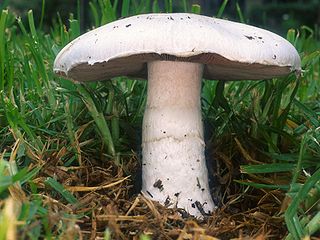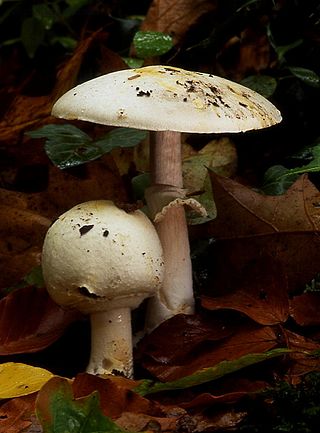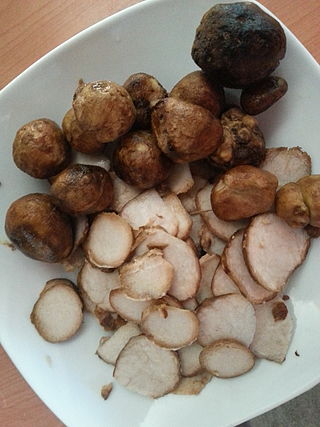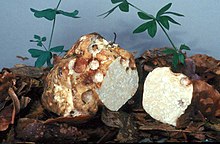
The Agaricales are an order of fungi in the division Basidiomycota. As originally conceived, the order contained all the agarics, but subsequent research has shown that not all agarics are closely related and some belong in other orders, such as the Russulales and Boletales. Conversely, DNA research has also shown that many non-agarics, including some of the clavarioid fungi and gasteroid fungi belong within the Agaricales. The order has 46 extant families, more than 400 genera, and over 25,000 described species, along with six extinct genera known only from the fossil record. Species in the Agaricales range from the familiar Agaricus bisporus and the deadly Amanita virosa to the coral-like Clavaria zollingeri and bracket-like Fistulina hepatica.

Agaricus silvicola, also known as the wood mushroom or woodland agaricus, is a species of Agaricus mushroom related to the button mushroom. A. silvicola is a member of Agaricus section Arvenses, a group of morphologically similar mushrooms. A. silvicola, like other species in Agaricus section Arvenses, exhibits a positive Schäffer's reaction and potassium hydroxide reaction, and smells of almonds or anise.

Discina is a genus of ascomycete fungi related to the false morels of the genus Gyromitra. There are about 20 species in the genus. They bear dish- or cup-shaped fruit bodies. The best known member is the pig ear (D. ancilis), which is deemed edible after thorough cooking, although is viewed with suspicion given its relation to the highly toxic false morels.

The Pyronemataceae are a family of fungi in the order Pezizales. It is the largest family of the Pezizales, encompassing 75 genera and approximately 500 species. Phylogenetic analyses does not support the prior classifications of this family, and suggest that the family is not monophyletic as it is currently circumscribed.

Gautieria is a genus of hypogeal fungi in the family Gomphaceae. They form mycorrhizae with various tree species, mostly from the family Pinaceae. Species are present over much of the world's temperate and boreal forest habitats. It is well documented that species from this genera are an important part of the diet of the northern flying squirrel. Also, some Australian marsupials, especially the rat-kangaroos, feed extensively on these fungi. The fungi also benefit from this relationship: not only do the squirrels help to disperse the spores and propagate the species, studies suggest that passage through the digestive tract of a mammal promotes germination of spores.

Genea is a genus of truffle-like fungi in the family Pyronemataceae. There are about 32 species in the genus that occur in North America and Europe.

Pilophorus is a genus of lichen-forming fungi in the family Cladoniaceae. They are commonly known as matchstick lichens. The genus has a widespread distribution, especially in temperate regions, and contains 11 species. The genus was circumscribed by Theodor Magnus Fries in 1857, with Pilophorus robustus assigned as the type species.

Kalaharituber is a fungal genus in the family Pezizaceae. It is a monotypic genus, whose single truffle-like species, Kalaharituber pfeilii, is found in the Kalahari Desert, which spans the larger part of Botswana, the east of Namibia and the Northern Cape Province of South Africa.

Balsamia is a genus of truffle-like ascomycete fungi of the family Helvellaceae. The widespread genus contains twenty five species known from Europe, North America, North Africa and Asia, including China.

Octaviania is a genus of truffle-like fungi in the family Boletaceae. The widespread genus is estimated to contain 15 species.
Tuber anniae is a species of truffle in the genus Tuber. The truffle is purported to be uncommon, but is primarily found in the United States Pacific Northwest. Recently the fruiting of closely related taxa have been found in the Baltic Rim countries, primarily forests dominated by Scots pine in eastern Finland.
William Bridge Cooke was an American mycologist. He specialized in fungal ecology and taxonomy, with on emphasis on the Polyporaceae. He was the author of at least 192 publications and five books. Cooke also published many fungal taxa: 3 subfamilies, 10 genera, 1 section, 144 new species, 4 subspecies and varieties, and 141 new combinations. Cooke received a Bachelor's degree in botany from the University of Cincinnati in 1932, and a Master of Science in 1939 at Oregon State University. After serving in the army during World War II, Cooke obtained a Ph.D. in 1950 from the Washington State University under the supervision of Rexford F. Daubenmire. With Charles Gardner Shaw he edited the exsiccata Reliquiae Suksdorfiana. Fungi collected by Wilhelm N. Suksdorf 1882-1927.










